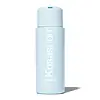Kosas Good Body Skin AHA + Enzyme Exfoliating Body Wash Versus Zitsticka SILKSHAKE Probiotic-Rich Body Wash
What's inside
What's inside
 Key Ingredients
Key Ingredients

 Benefits
Benefits

 Concerns
Concerns

 Ingredients Side-by-side
Ingredients Side-by-side

Water
Skin ConditioningCocamidopropyl Hydroxysultaine
CleansingSodium Methyl Cocoyl Taurate
CleansingGlycerin
HumectantSodium Cocoyl Isethionate
CleansingCapryloyl/Caproyl Methyl Glucamide
EmulsifyingGlycolic Acid
BufferingLactic Acid
BufferingMandelic Acid
AntimicrobialCitric Acid
BufferingPapain
Skin ConditioningBromelain
Skin ConditioningAllantoin
Skin ConditioningMaltodextrin
AbsorbentSodium Gluconate
Skin ConditioningGlyceryl Oleate
EmollientPotassium Sorbate
PreservativeSodium Chloride
MaskingParfum
MaskingWater, Cocamidopropyl Hydroxysultaine, Sodium Methyl Cocoyl Taurate, Glycerin, Sodium Cocoyl Isethionate, Capryloyl/Caproyl Methyl Glucamide, Glycolic Acid, Lactic Acid, Mandelic Acid, Citric Acid, Papain, Bromelain, Allantoin, Maltodextrin, Sodium Gluconate, Glyceryl Oleate, Potassium Sorbate, Sodium Chloride, Parfum
Water
Skin ConditioningSodium Cocoyl Glycinate
CleansingGlycerin
HumectantSodium Lauroamphoacetate
CleansingAcrylates Copolymer
Cocamidopropyl Betaine
CleansingInulin
Skin ConditioningSodium Chloride
MaskingBenzyl Alcohol
PerfumingMyristic Acid
CleansingCocos Nucifera Fruit Extract
EmollientEthylhexylglycerin
Skin ConditioningMelaleuca Alternifolia Leaf Oil
AntioxidantSodium Gluconate
Skin ConditioningGlycol Stearate
EmollientLauric Acid
CleansingCaprylhydroxamic Acid
Lactobacillus Ferment
Skin ConditioningAvena Sativa Bran Extract
AbrasiveFructose
HumectantCocamidopropyl Dimethylamine
EmulsifyingLeuconostoc/Radish Root Ferment Filtrate
AntimicrobialEuterpe Oleracea Fruit Extract
Dimethylaminopropylamine
Linoleic Acid
CleansingOleic Acid
EmollientLinolenic Acid
CleansingWater, Sodium Cocoyl Glycinate, Glycerin, Sodium Lauroamphoacetate, Acrylates Copolymer, Cocamidopropyl Betaine, Inulin, Sodium Chloride, Benzyl Alcohol, Myristic Acid, Cocos Nucifera Fruit Extract, Ethylhexylglycerin, Melaleuca Alternifolia Leaf Oil, Sodium Gluconate, Glycol Stearate, Lauric Acid, Caprylhydroxamic Acid, Lactobacillus Ferment, Avena Sativa Bran Extract, Fructose, Cocamidopropyl Dimethylamine, Leuconostoc/Radish Root Ferment Filtrate, Euterpe Oleracea Fruit Extract, Dimethylaminopropylamine, Linoleic Acid, Oleic Acid, Linolenic Acid
 Reviews
Reviews

Ingredients Explained
These ingredients are found in both products.
Ingredients higher up in an ingredient list are typically present in a larger amount.
Glycerin is already naturally found in your skin. It helps moisturize and protect your skin.
A study from 2016 found glycerin to be more effective as a humectant than AHAs and hyaluronic acid.
As a humectant, it helps the skin stay hydrated by pulling moisture to your skin. The low molecular weight of glycerin allows it to pull moisture into the deeper layers of your skin.
Hydrated skin improves your skin barrier; Your skin barrier helps protect against irritants and bacteria.
Glycerin has also been found to have antimicrobial and antiviral properties. Due to these properties, glycerin is often used in wound and burn treatments.
In cosmetics, glycerin is usually derived from plants such as soybean or palm. However, it can also be sourced from animals, such as tallow or animal fat.
This ingredient is organic, colorless, odorless, and non-toxic.
Glycerin is the name for this ingredient in American English. British English uses Glycerol/Glycerine.
Learn more about GlycerinChances are, you eat sodium chloride every day. Sodium Chloride is also known as table salt.
This ingredient has many purposes in skincare: thickener, emulsifier, and exfoliator.
You'll most likely find this ingredient in cleansers where it is used to create a gel-like texture. As an emulsifier, it also prevents ingredients from separating.
There is much debate on whether this ingredient is comedogenic. The short answer - comedogenic ratings don't tell the whole story. Learn more about comegodenic ratings here.
The concensus about this ingredient causing acne seems to be divided. Research is needed to understand if this ingredient does cause acne.
Scrubs may use salt as the primary exfoliating ingredient.
Learn more about Sodium ChlorideThis is the synthetic salt of gluconic acid, a form of PHA and mild exfoliant.
It is mainly used to stabilize oil and butter formulations from going bad. Sodium gluconate is a humectant, pH regulator, and chelating agent.
Chelating agents help neutralize unwanted metals from affecting the formulation.
Sodium gluconate is water-soluble.
Learn more about Sodium GluconateWater. It's the most common cosmetic ingredient of all. You'll usually see it at the top of ingredient lists, meaning that it makes up the largest part of the product.
So why is it so popular? Water most often acts as a solvent - this means that it helps dissolve other ingredients into the formulation.
You'll also recognize water as that liquid we all need to stay alive. If you see this, drink a glass of water. Stay hydrated!
Learn more about Water